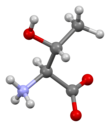Threonine
 Skeletal formula of L-threonine
| |||
| |||
| Names | |||
|---|---|---|---|
| IUPAC name
Threonine
| |||
| Other names
2-Amino-3-hydroxybutanoic acid
| |||
| Identifiers | |||
3D model (
JSmol ) |
|||
| ChEBI |
| ||
| ChEMBL |
| ||
| ChemSpider |
| ||
| DrugBank |
| ||
ECHA InfoCard
|
100.000.704 | ||
| EC Number |
| ||
IUPHAR/BPS |
| ||
| KEGG |
| ||
PubChem CID
|
| ||
| UNII |
| ||
CompTox Dashboard (EPA)
|
|||
| |||
| |||
| Properties | |||
| C4H9NO3 | |||
| Molar mass | 119.120 g·mol−1 | ||
| (H2O, g/dl) 10.6(30°),14.1(52°),19.0(61°) | |||
| Acidity (pKa) | 2.63 (carboxyl), 10.43 (amino)[1] | ||
| Supplementary data page | |||
| Threonine (data page) | |||
Except where otherwise noted, data are given for materials in their standard state (at 25 °C [77 °F], 100 kPa).
| |||
Threonine (symbol Thr or T)
Threonine sidechains are often hydrogen bonded; the most common small motifs formed are based on interactions with
Modifications
The threonine residue is susceptible to numerous
History
Threonine was the last of the 20 common
Stereoisomers
  |
| L-threonine (2S,3R) and D-threonine (2R,3S) |
  |
| L-allothreonine (2S,3S) and D-allothreonine (2R,3R) |
Threonine is one of two proteinogenic amino acids with two
Biosynthesis
As an essential amino acid, threonine is not synthesized in humans, and needs to be present in proteins in the diet. Adult humans require about 20 mg/kg body weight/day.[8] In plants and microorganisms, threonine is synthesized from aspartic acid via α-aspartyl-semialdehyde and homoserine. Homoserine undergoes O-phosphorylation; this phosphate ester undergoes hydrolysis concomitant with relocation of the OH group.[9] Enzymes involved in a typical biosynthesis of threonine include:
- aspartokinase
- β-aspartate semialdehyde dehydrogenase
- homoserine dehydrogenase
- homoserine kinase
- threonine synthase.

Metabolism
Threonine is metabolized in at least three ways:
- In many animals it is converted to threonine dehydrogenase. An intermediate in this pathway can undergo thiolysis with CoA to produce acetyl-CoA and glycine.
- In humans the gene for threonine dehydrogenase is an inactive α-ketobutyrate. The mechanism of the first step is analogous to that catalyzed by serine dehydratase, and the serine and threonine dehydratase reactions are probably catalyzed by the same enzyme.[11]
- In many organisms it is (R)-1-aminopropan-2-ol for incorporation into the vitamin's sidechain.[12]
- Threonine is used to synthesize glycine during the endogenous production of L-carnitine in the brain and liver of rats.[13][14]
Metabolic diseases
The degradation of threonine is impaired in the following metabolic diseases:
- Combined malonic and methylmalonic aciduria (CMAMMA)[15]
- Methylmalonic acidemia[15]
- Propionic acidemia[16]
Research of Threonine as a Dietary Supplement in Animals
Effects of threonine dietary supplementation have been researched in broilers.[17]
An essential amino acid, threonine is involved in the metabolism of fats, the creation of proteins, the proliferation and differentiation of
Sources
Foods high in threonine include cottage cheese, poultry, fish, meat, lentils, black turtle bean[19] and sesame seeds.[20]
References
- ^ Dawson, R.M.C., et al., Data for Biochemical Research, Oxford, Clarendon Press, 1959.
- ^ "Nomenclature and Symbolism for Amino Acids and Peptides". IUPAC-IUB Joint Commission on Biochemical Nomenclature. 1983. Archived from the original on 9 October 2008. Retrieved 5 March 2018.
- PMID 11368769.
- )
- .
- .
- ISBN 978-0-309-08525-0.
- ISBN 1-57259-153-6..
- ISBN 9780323266956.
- ISBN 9788131795286.
- PMID 28137297.
- S2CID 3708658.
- PMID 32867295.
- ^ PMID 20301409, retrieved 2024-03-09
- PMID 22593918, retrieved 2024-03-09
- ISSN 2300-8733.
- ^ Tang, Qi; Peng, Tan; Ning, Ma; Xi, Ma (2021-07-28). "Physiological Functions of Threonine in Animals: Beyond Nutrition Metabolism". Nutrients. 13 (8): 2592 – via NCBI.
- ^ "Error". ndb.nal.usda.gov. Archived from the original on 2018-11-16. Retrieved 2013-05-29.
- ^ "SELF Nutrition Data - Food Facts, Information & Calorie Calculator". nutritiondata.self.com. Retrieved 27 March 2018.
- ^ Carter, Herbert E.; West, Harold D. (1940). "dl-Threonine". Organic Syntheses. 20: 101; Collected Volumes, vol. 3, p. 813..



